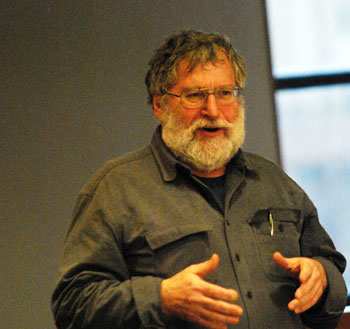Ypsilanti May Ask to Join AATA
The Ypsilanti city council might ask that Ypsilanti join the Ann Arbor Transportation Authority. Ypsilanti city councilmember Pete Murdock informed the AATA board of that possibility during remarks at the board’s April 18, 2013 meeting. On the Ypsilanti city council’s agenda for April 23 is a resolution making the request. [.pdf of Ypsilanti council resolution]

Ypsilanti councilmember Pete Murdock addressed the AATA board meeting on April 18, 2013. (Photo by the writer.)
The resolution enjoys the support of Murdock as well as Ypsilanti mayor Paul Schreiber, who indicated his support in a phone interview with The Chronicle.
Murdock’s news was met with some nods around the AATA board table, and with an assurance from AATA board chair Charles Griffith that the board would give the request full consideration.
Ypsilanti’s possible request comes in the context of an attempt in 2012 to improve public transit by forming a countywide authority. That authority, incorporated under Act 196 of 1986 in mid-2012 and spearheaded by the AATA, was for all practical purposes ended late last year when the Ann Arbor city council voted to opt out of the new transit authority at its Nov. 8, 2012 meeting.
Of the 28 municipalities in Washtenaw County, the city of Ypsilanti is the only one that didn’t opt out. That transit authority, called the Washtenaw Ride, was formally dissolved this week by the Washtenaw County board of commissioners at its April 17, 2013 meeting.
But under the direction of the Ann Arbor city council, the AATA has been meeting with representatives of the county’s “urban core” communities to discuss possible expanded public transit within a limited area around Ann Arbor. It would be a smaller effort than the previous attempt at countywide service. The AATA hosted a meeting on March 28 at Pittsfield Township Hall to go over details about where improvements or expansion might occur, and how much it might cost. [See Chronicle coverage: "Costs, Services Floated for Urban Core Transit."]
Ypsilanti’s request to join the AATA would be made under a provision of Act 55 of 1963, under which the AATA was originally incorporated. [.pdf of AATA articles of incorporation] [.pdf of Act 55 of 1963] Admission of Ypsilanti as a member would require a majority vote by the AATA board. It would also require that the articles of incorporation for the AATA be amended – which might require action by the Ann Arbor city council.
Act 55 states: ”If a political subdivision joins the authority, the board shall amend the articles of incorporation accordingly.” In the past, however, it’s been through a resolution of the Ann Arbor city council that the articles of incorporation have been amended. In that case, the number of board members was increased to seven.
Membership in the AATA has possible implications for governance, including the possibility that through the articles of incorporation or bylaws, the city of Ypsilanti would be represented in some fashion on the AATA board. But the goal of adding Ypsilanti would include providing a more solid funding foundation for the service that AATA already operates between the two cities. Currently, that’s funded in part through a purchase-of-service agreement (POSA) between the AATA and Ypsilanti.
The two cities each already have millages that are designated to support public transportation. Ann Arbor’s millage is perpetual, passed in 1973 at a rate of 2.5 mills. The Headlee rollback has reduced that rate to just over 2 mills currently. Ypsilanti voters in November 2010 authorized a Headlee override of the city’s charter millage, restoring it to the originally authorized level of 20 mills, designating the additional 0.9789 mills for public transit purposes. The AATA does not currently exercise its Act 55 statutory ability to levy taxes itself – which it could do on approval of a majority of voters who live in member jurisdictions.
To sustain and improve transportation in the area, the AATA has indicated that additional funding would be required. At the March 28 meeting at Pittsfield Township Hall, four basic scenarios for transportation service in the urban core were presented for consideration: sustain, improve, expand, or expand and improve. [.pdf of March 28, 2013 meeting packet] For the “improve” scenario, the combined total of additional funding that would be required from the city of Ypsilanti and the city of Ann Arbor was between $1.7 million and $2.65 million – depending on the cost allocation methodology.
Based on the Washtenaw County 2013 equalization report, the taxable value of all property in the city of Ypsilanti is $289.6 million. And in the city of Ann Arbor, the taxable value of all property is $4.840 billion. A tax rate of 1 mill is $1 for each $1,000 of taxable value. So Ypsilanti’s transit millage will generate roughly $283,000 this year, while Ann Arbor’s transit millage will generate roughly $9.6 million.
Given the combined taxable value in the two cities, a new AATA millage rate of a bit more than half a mill would be needed to cover the additional $2.65 million required under the “improve” scenario [.52*(4,840,000,000+289,000,000)/1000= 2,667,080].
This brief was filed the day after the AATA board’s April 18 meeting. A more detailed report of the meeting will follow: [link]



